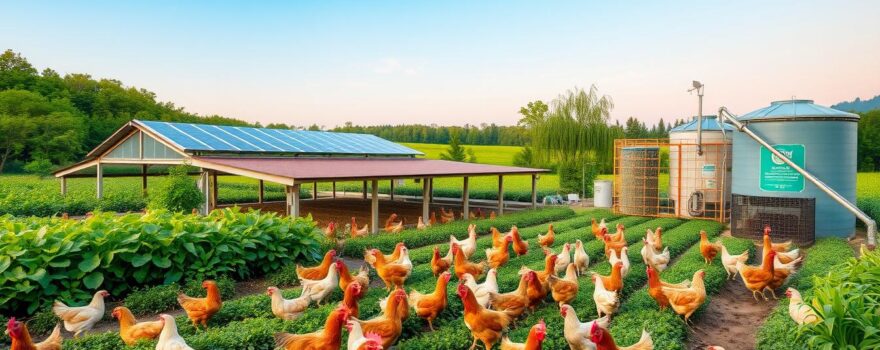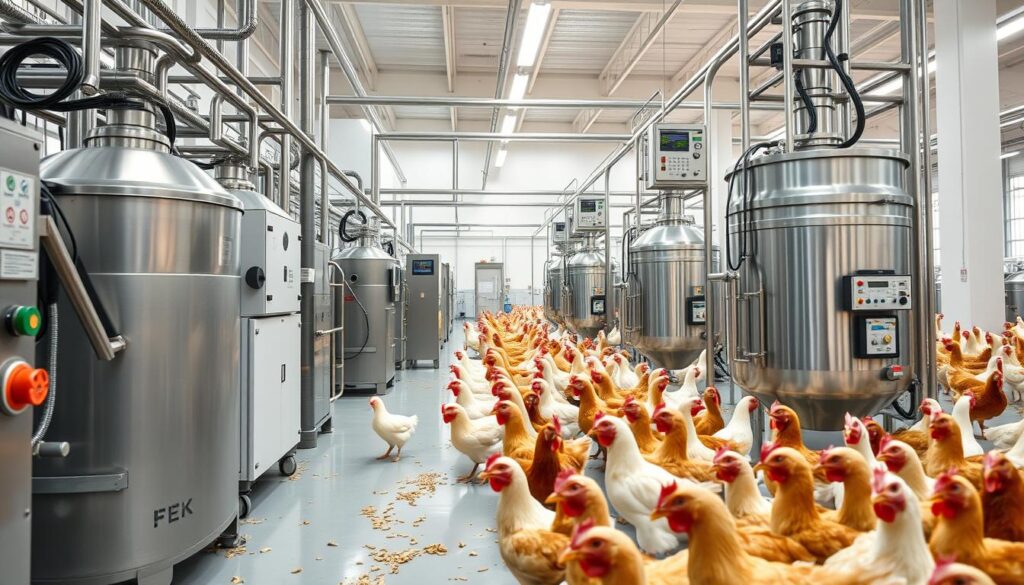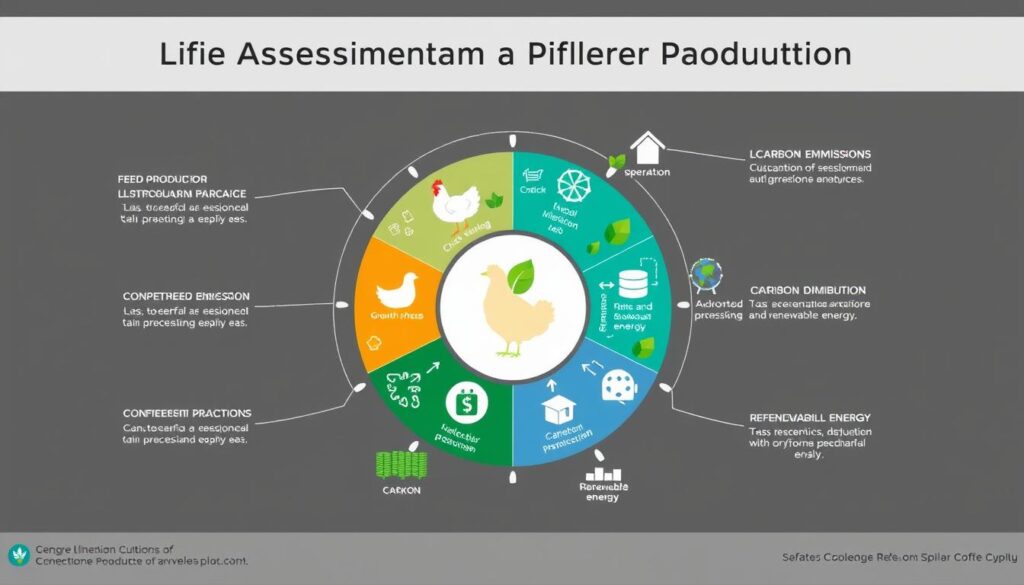
The global broiler industry is key in meeting the world’s growing need for protein. However, its environmental impact is significant. With global chicken production hitting 121.5 million metric tons in 2021, the industry must cut its carbon footprint. Sustainable poultry farming is crucial, covering feed production, transportation, waste management, and energy use.
To tackle this, poultry producers and stakeholders need to find new ways to How to Minimize the Carbon Footprint of Broiler Chicken Production, broiler chicken environmental impact, and reducing greenhouse gas emissions in poultry. This includes better feed efficiency, alternative proteins, and renewable energy. A broad approach is needed to make real changes in the industry’s carbon footprint.
Key Takeaways
- The global broiler industry contributes significantly to greenhouse gas emissions, with 78% of emissions originating from feed production, processing, and transportation.
- Replacing soybean meal, a feed ingredient associated with high carbon footprint due to land use change, is critically important for reducing the industry’s environmental impact.
- Genetic improvement, alternative protein sources, feed processing technologies, precision feeding, and manure management strategies all have the potential to minimize the carbon footprint of broiler production.
- Implementing renewable energy and energy-efficient practices in broiler houses can further reduce the industry’s reliance on fossil fuels and greenhouse gas emissions.
- Comprehensive life cycle assessment and carbon offsetting strategies are essential for quantifying and mitigating the broiler industry’s environmental impact.
Introduction to Broiler Production and Carbon Footprint
Broiler chickens are key in the global food supply. Chicken meat production has grown a lot in recent years worldwide. In the tropics, broiler production is especially important because of high demand and the climate’s suitability for year-round farming.
The Role of Broiler Chickens in Global Food Supply
Poultry meat, like broiler chickens, is a big part of our food. The European Union is a major meat producer, with 31% being poultry. Broiler chickens are cheap and efficient, making them crucial for our food system.
Understanding Carbon Footprint and Greenhouse Gas Emissions
The carbon footprint measures greenhouse gas emissions from activities or sectors. The broiler industry has a smaller carbon footprint than other animal farming. Yet, it still makes a big impact on greenhouse gas emissions.
Feed production, energy use, and manure management in broiler chicken farming lead to these emissions. In the U.S., 6.9 percent of greenhouse gas emissions come from agriculture, with 0.6 percent from poultry. In 2008, fossil fuel use caused 94.1 percent of U.S. CO2 emissions. Methane and nitrous oxide, mainly from agriculture, made up 15 percent of total GHG emissions.
Poultry farming can be carbon neutral if done sustainably. Lower methane emissions from poultry compared to grazing animals help. Using renewable energy, being energy-efficient, and managing waste can reduce broiler production’s carbon footprint.
How to Minimize the Carbon Footprint of Broiler Chicken Production
The demand for poultry meat is growing, and the poultry industry must reduce its environmental impact. Fortunately, there are many ways to cut down the carbon footprint of broiler chicken production.
One effective strategy is to use less soybean meal in feed. Soybean meal can lead to high greenhouse gas emissions because of land-use changes. Looking into alternative proteins like insect meal, algae, and microbial protein can help. These options can make the feed supply more diverse and lower emissions.
Genetic selection and better feed processing can also make a big difference. By improving how nutrients are used, farmers can need less feed for the same amount of meat. This means fewer emissions.
| Emission Source | Contribution to Carbon Footprint |
|---|---|
| Feed production | 50-85% |
| Manure management | Approximately 10% |
| Fuel use on farms | Around 90% of emissions from poultry-production farms |
Good manure management is also key. Using physical, chemical, and biological treatments can cut down on greenhouse gas emissions. Looking into anaerobic digestion for manure can help reduce emissions and even produce renewable energy.
Finally, making broiler houses more energy-efficient can help. This includes using renewable energy and upgrading insulation. Installing heat pumps and optimizing farm equipment can also make a big impact.
By using a mix of these strategies, the poultry industry can lessen the carbon footprint of broiler chicken production. This helps in the bigger goal of cutting down greenhouse gas emissions.
Reducing Dependence on Soybean Meal
The poultry industry is working hard to cut down its carbon footprint. It’s focusing on using less soybean meal in broiler diets. Soybean production can lead to deforestation and greenhouse gas emissions. By using other protein sources, the carbon footprint of broiler production can drop by up to 20%.
Alternatives to Soybean Meal in Broiler Diets
Scientists have found several alternatives to soybean meal for broiler diets. These include:
- Beans
- Rapeseed meal
- Legumes
These options can replace soybean meal and lower emissions from land use. But, the industry needs to figure out what makes a diet “soya-free.” This includes replacing soya oil as well.
Sourcing Sustainable Soy: Avoiding Land Use Change
It’s important to develop the supply chain and processing for these alternatives. Also, making sure soy is produced sustainably is key. Studies show soybean production can cause deforestation, so we need to source soy responsibly.
| Emission Source | Contribution to Poultry Meat Sector Emissions |
|---|---|
| Purchased Feed | 82% |
| Manure Management | 9% |
| Fuel | 6% |
| Purchased Bedding | 2% |
| Electricity | 1% |
“Clear thinking is crucial for a profitable low carbon poultry industry, with adjustments in poultry diets and reduced reliance on soya posing challenges that require realistic timeframes.”
Optimizing Feed Efficiency and Genetic Improvement
To cut down the carbon footprint of broiler farming, we focus on better feed efficiency and genetic advancements. The broiler industry has seen a lot of genetic changes. Even small improvements can make a big difference in reducing environmental harm.
Genetic selection has greatly improved broiler performance. From 1988 to 2007, there was a big drop in greenhouse gas emissions. Methane, nitrous oxide, and ammonia emissions fell by 20%, 23%, and 10% respectively. This shows how breeding can lead to more eco-friendly broiler farming.
Feed efficiency is key in broiler farming, and genetic changes have helped a lot. Traits like feed conversion ratio (FCR), residual feed intake (RFI), and coefficient of digestibility (CDU) have shown a lot of genetic variation. This makes them great targets for breeding improvements. The heritability of these traits is between 0.16 and 0.35, showing a big genetic potential for improvement.
| Trait | Heritability Range | Importance |
|---|---|---|
| Feed Conversion Ratio (FCR) | 0.16 – 0.35 | A key measure of feed efficiency, with genetic variability allowing for improvement |
| Residual Feed Intake (RFI) | 0.16 – 0.35 | Evaluates the efficiency of feed utilization, with more efficient animals showing lower than predicted energy requirements |
| Coefficient of Digestibility (CDU) | 0.16 – 0.35 | Reflects the proportion of nutrients digested and absorbed, playing a crucial role in reducing nutrient excretion and environmental impact |
By always working to improve feed efficiency in broilers and using genetic selection for important traits, the broiler industry can help make the future more sustainable. This will lower the carbon footprint and environmental harm of broiler farming.
Exploring Alternative Protein Sources
The poultry industry is looking for ways to cut down on carbon emissions. It’s turning to insect meal, algae, and microbial protein as new options. These alternatives could help reduce soybean meal use and its environmental impact, making broiler production more sustainable.
Insect Meal: A Sustainable Protein Powerhouse
Insect meal comes from black soldier flies and mealworms. It’s a strong protein source for broiler chickens. Research shows it boosts growth, nutrient absorption, and meat quality. Plus, it’s more resource-efficient than traditional proteins, saving costs and improving efficiency.
Algae: The Untapped Protein Potential
Algae are packed with protein, up to 50-70%. They’re being looked at as a green feed option for broilers. Using algae proteins can lessen soybean meal use, making poultry farming more eco-friendly.
Microbial Protein: The Future of Feed
Microbial protein is made from fermented single-celled organisms. It’s a protein-rich option for broiler diets. It could help cut down the carbon footprint of broiler farming.
As the poultry industry aims to reduce its environmental impact, these new protein sources are key. Using insect meal, algae, and microbial protein in broiler feed can pave the way for a greener future.
| Protein Source | Protein Content | Potential Benefits |
|---|---|---|
| Insect Meal | 40-60% | Improved growth performance, nutrient digestibility, and carcass/meat quality |
| Algae | 50-70% | Renewable and eco-friendly source of protein |
| Microbial Protein | Varies | Reduction in soybean meal usage and carbon footprint |
Improving Feed Processing and Precision Feeding
Advances in feed processing technologies and the use of special ingredients like synthetic amino acids and enzymes can cut down on carbon emissions from broiler farms. Precision feeding and management also show promise in reducing emissions, but they might be more expensive at first. Yet, as technology advances, these methods could become more affordable and accessible.
Enzymes and Synthetic Amino Acids
The addition of enzymes and synthetic amino acids to broiler diets can boost nutrient use and feed efficiency. This leads to less feed being needed and lower emissions per broiler. Studies suggest these additives can improve how well protein is used in poultry, offering environmental benefits.
- Dietary crude protein conversion efficiency for broilers ranges from 30% to 40%.
- Broilers have a net protein contribution score of approximately 0.76.
- Precision nutrition can reduce nitrogen and phosphorus excretion, as well as greenhouse gas emissions in broiler production.
The broiler industry is working hard to make feed more efficient and reduce its environmental footprint. The strategic use of enzymes and synthetic amino acids in feed processing will become even more crucial.

“Feeding once a day results in a 3% to 5% improvement in feed efficiency compared to other feeding methods.”
Precision feeding systems are also being looked into to boost feed efficiency and flock uniformity in broiler production. These new technologies can offer tailored nutrition to birds based on their weight. This could lead to less feed being used and lower environmental impacts.
Manure Management Strategies
Managing broiler manure is key to reducing the carbon footprint of poultry farming. Proper handling and treatment of manure can cut down on greenhouse gas emissions. This helps the environment a lot.
Physical, Chemical, and Biological Treatment of Manure
Physical methods like stacking and pelleting manure can lower emissions. Chemical and biological treatments can improve these efforts. But, we need more research to find the best and most affordable ways.
Alternative Manure Management Systems
Using litter as fuel or for anaerobic digestion is a smart alternative. It cuts down on emissions and reduces ammonia and odors. This makes broiler farming more eco-friendly.
| Manure Management Strategies | Benefits |
|---|---|
| Physical Treatment (Improved Stacking, Pelleting) | Reduced greenhouse gas emissions |
| Chemical and Biological Treatment | Further emission reductions, but optimal design and feasibility still require more research |
| Alternative Systems (Litter-to-Fuel, Anaerobic Digestion) | Reduced greenhouse gas emissions, ammonia, and odors; enhanced environmental sustainability |
Good broiler manure management is vital for reducing the poultry industry’s carbon footprint. By trying out different treatments and systems, farmers can lessen emissions. This makes food production more sustainable.
Renewable Energy and Energy Efficiency in Broiler Houses
Broiler production is key to feeding the world but has a big carbon footprint. Using renewable energy and energy-saving tech in broiler houses can help a lot. It cuts down on greenhouse gases and saves money in the long run.
Photovoltaic (PV) systems are a big help for broiler houses. They can save up to 85% of energy, paying off in 3 to 8 years. Solar collectors, hybrid PV/Thermal systems, and heat pumps also boost energy use and green energy in these places.
Broiler producers can also cut energy use by upgrading lights and adding radiant heating. These changes lower energy bills and make the birds healthier and more productive.
By focusing on both renewable energy and energy saving, broiler producers can greatly reduce their carbon footprint. This is good for the planet and helps their businesses stay strong and cost-effective over time.
Key Strategies for Renewable Energy and Energy Efficiency in Broiler Houses
- Implement photovoltaic (PV) solar power systems for up to 85% energy savings
- Utilize solar collectors, hybrid PV/Thermal systems, and ground/water/air source heat pumps
- Optimize lighting and install radiant heating systems for improved energy efficiency
- Leverage a combination of renewable energy and energy-efficient technologies to achieve maximum impact
“Embracing renewable energy and energy-efficient technologies in broiler houses is a win-win solution, benefiting both the environment and the producer’s bottom line.”
Life Cycle Assessment and Carbon Offsetting
Doing a life cycle assessment of broiler production helps us understand all the greenhouse gas emissions. This info can lead to carbon offsetting in the poultry industry. Ways to do this include using renewable energy or practices that absorb carbon.
In 2019, the world produced 118 million tonnes of chicken meat, which is about 35% of all meat. This number has grown ten times in the last 50 years. By 2029, chicken meat production is expected to rise by 20 million tonnes, making up half of the global meat increase.
Broiler chicken production has bigger environmental effects than plant proteins like soybean. The poultry industry, including broilers, also releases a lot of ammonia, which harms the environment. Scientists are looking into using special diets for broilers to cut down on nitrogen waste.
Another idea is to burn broiler litter as fuel, which can heat broiler houses without extra fuel. But, we need more research on the environmental effects of these methods. The life cycle assessment (LCA) method is good for studying their impacts.
| Broiler Production Metrics | Values |
|---|---|
| Average Slaughter Age | 52 days |
| Average Slaughter Weight | 3.06 kg |
| Feed Conversion Ratio | 1.98 |
| Conventional Broiler Diet (First Stage) | 21.7% Crude Protein |
| Conventional Broiler Diet (Second Stage) | 19.5% Crude Protein |
By doing a detailed life cycle assessment and finding ways to carbon offset, the poultry industry can get better at protecting the environment. This is while still meeting the increasing demand for broiler production.

Reducing the carbon footprint of broiler production is key for the poultry industry’s future. By using less soybean meal, improving feed efficiency, and finding new protein sources, producers can cut down on emissions. They also need to manage manure better and use more renewable energy.
To lower carbon footprint, broiler producers should look at the whole production process. They should also consider carbon offsetting and keep up with new research. This way, the industry can help fight climate change and meet the demand for affordable, quality poultry.
By adopting these green practices, the broiler industry can lessen its environmental harm. It can also show it cares about responsible food production. As more people want sustainable food, the industry’s ability to reduce its carbon footprint will be crucial for staying competitive.